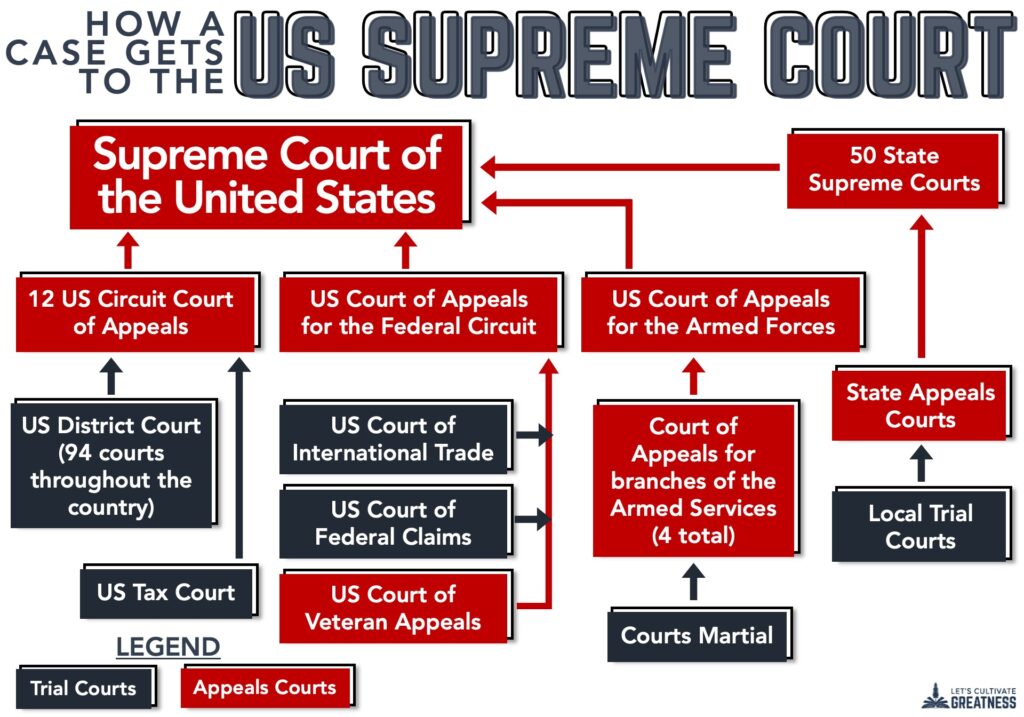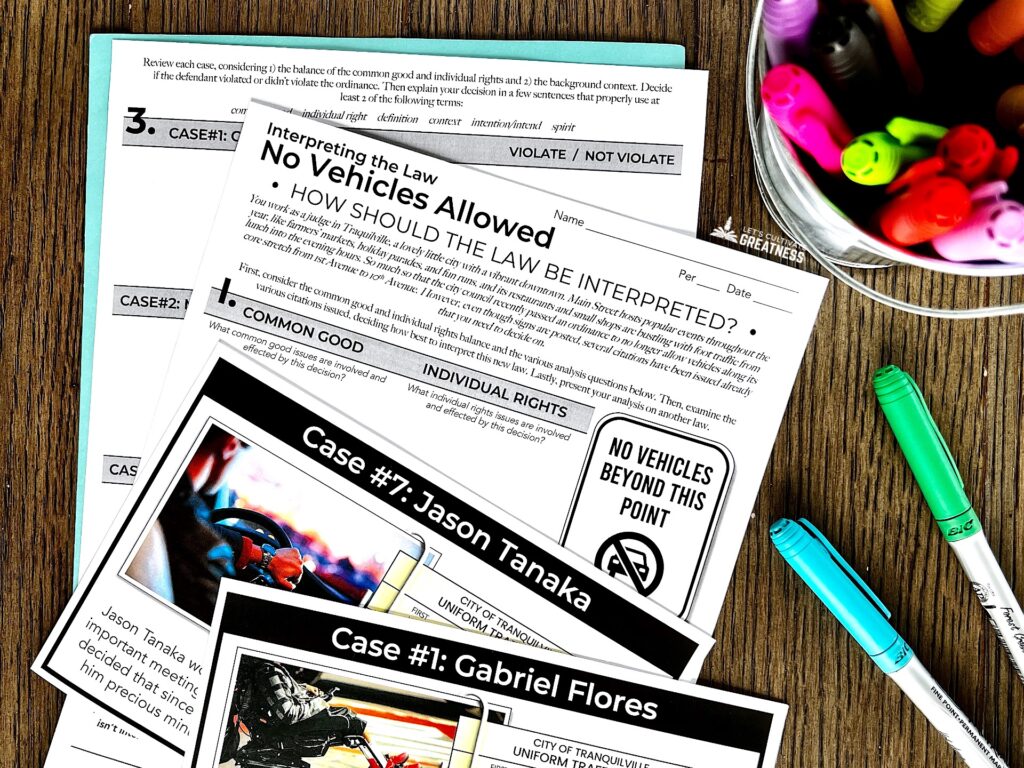The judicial branch has always been my favorite of the three branches to teach, perhaps because it’s the most skimmed-over and underappreciated.
Even almost 250 years later, it still hasn’t fully shaken off Alexander Hamilton’s famous brush-off when he called it the“least dangerous branch.”
Of course, in recent years, the branch, particularly the Supreme Court, has gotten increasing attention with its sharp turn to a conservative super-majority that has led to several news-making rulings.
But still, I always find my seniors have little incoming knowledge of exactly what the Supreme Court does or what it means to interpret laws.
So included here are some of my favorite lessons and activities for teaching the judicial branch in my high school Civics and Government class. But first, let’s go over the basics of the Supreme Court and the judicial process.
What does the Judicial Branch Do?
The primary job of any court system is to properly interpret the meaning of a law and apply it fairly to individual cases. A jury usually does this work with a judge presiding over the trial.
If there’s an appeal because one side feels that didn’t happen, then an appellant court examines that aspect of the case. Those don’t have juries; instead, they have panels of judges who decide.
This second set of courts is a much smaller part of the court system, but since that’s what the Supreme Court is, I find most students misunderstand the federal courts as only that.

The Supreme Court is the top appeals, or appellant, court, but it has a whole network of courts beneath it. These special courts can overturn lower decisions if they feel the law violates the Constitution. This power is called judicial review.
It’s in this power that the judicial branch touches everyday life pretty significantly. And the federal court system is a more extensive network than most realize. There are many paths for a case to travel up to the Supreme Court.
I find that teaching this branch from the lens of why it is, in fact, much more powerful than we give it credit hooks in and engages my students all unit long.
Lesson Ideas for Teaching the Judicial Branch
First, since this branch is usually taught after the other two, don’t let those other branches make you run out of time. That inherently sends the message it’s not as important.
That said, I spend about 3 weeks teaching the judicial branch. Head to my store to grab these lesson activities for yourself as a done-for-you unit kit.
1. Examine the Constitution & Federalist Papers
First, give students the text of Article III, Section 1, where students can see how little the Constitution actually says. Never skip the opportunity to bring the original source to students!
Be sure to go over the basics of the Judiciary Act of 1789, too, since that is what really sets up the federal court system. This is where I like to show a map of the federal district and circuit courts so kids can see the ones we live in.
I’ll also pull up photos of our closest federal courthouse and court of appeals building. This helps make it more real. If you have the means, contact either of them for a possible field trip. They love to give students tours!
Lastly, to help introduce this branch, I have students analyze a few short excerpts from Antifederalist No. 15 and Federalist Paper No. 78. These really help set the stage for students about how, from the start, people feared the Supreme Court could become all-powerful, yet the Framers didn’t believe so.
I weave the text in chunks into my lecture slides as we cover the branch, but you could also hand out hard copies.
2. Simulate How to Interpret Laws
This is a really fun and essential activity because, when pressed, students struggle to grasp exactly what interpreting or clarifying the law means.
Pick an oversimplified hypothetical-but-realistic law or rule. Something like “no hats in school” or “all sugary drinks are subject to a one cent per ounce tax.” Then, come up with several scenarios to challenge students to decide and defend what qualifies as a violation or not.
For example, should a Jewish or Muslim student wearing a religious head covering violate the rule? (No, because of First Amendment rights). Or, a student wearing the hood of their sweatshirt up, covering their ears? (Probably).
Put the scenarios on cards for small groups to talk through or make stations to circulate among and create a recording sheet for students to decide and defend their thinking.

I do this activity using a “Main Street is closed to motorized vehicles” law, which always creates great debate over what counts as a motorized vehicle and which scenarios count as exceptions.
3. Examine Landmark Supreme Court Cases
Now that students understand the difficult task of the Supreme Court, they can better appreciate the decisions they’ve made in landmark cases regarding important Constitutional rights.
I detail this project in this blog post, so I’ll just give a brief overview here. Assign each student a landmark case—here’s a pretty extensive list I like to use. Then, task them to research the case, its backstory, and the Court’s ruling. I have them create a one-page poster of their case.

Then, use we them to create a gallery walk, posting them around your room. Students teach each other all about the nuances of their rights that these court cases created.
For example, Mapp v. Ohio confirmed the right to privacy with personal property, but California v. Greenwood clarified that you give up that right when you throw stuff in the garbage.
4. Explore the Current Docket and Justices
This is the time in our unit when I feel students are ready to explore the current-day court. Since the Supreme Court follows a fall-to-spring session like the school year, it’s easy to find news articles identifying “cases to follow this year.” They’re published every August or so.
Pick a couple and examine the Constitutional issues involved. You can then track the cases for the rest of the semester—when the case is heard and the ruling is announced.
Additionally, if you have time, have students explore the nine current Supreme Court justices. Their background, their leanings, their major rulings. You could do this as a simple worksheet or as a more formal poster-and-gallery-walk activity like mentioned above.
5. Research a Debated Issue
I like to culminate my Civics course with a Constitutional Issues research project. One of the topics I let students choose is if there should be Supreme Court term limits.
After having done these activities, students usually have strong opinions on this. But to make it a little more fun, I set it up as a PBL, where students take on the role of Presidential advisors.
That way, instead of a standard argumentative essay, students prepare a report on whether to recommend the President endorse a Constitutional amendment implementing limits. So basically, the same thing… just don’t tell my students that!
There are several high-quality sources out there to create your own DBQ-style prompt. A few sources I give my students to kick-start their research are this Harvard Business Review analysis that explores several term limit options and this expert testimony from a recent Presidential Commission on the matter.
And that’s it! Between these several activities, you’ve covered the branch and related standards well in just a few weeks.

Check out my Judicial Branch unit bundle for all the activities mentioned, which you can also purchase individually to plug and play into your existing unit.
Feature image photo credit: Tim Mossholder





